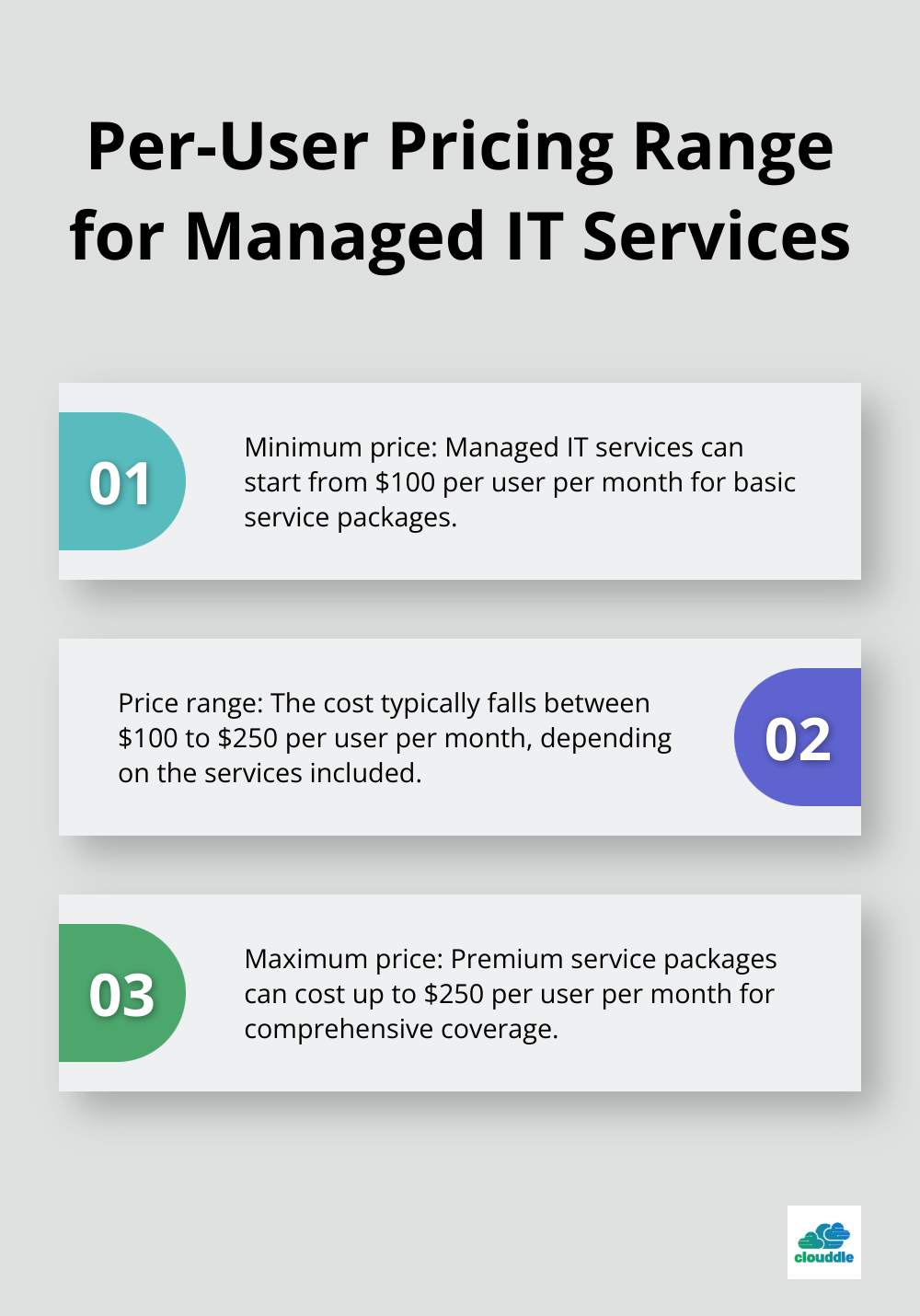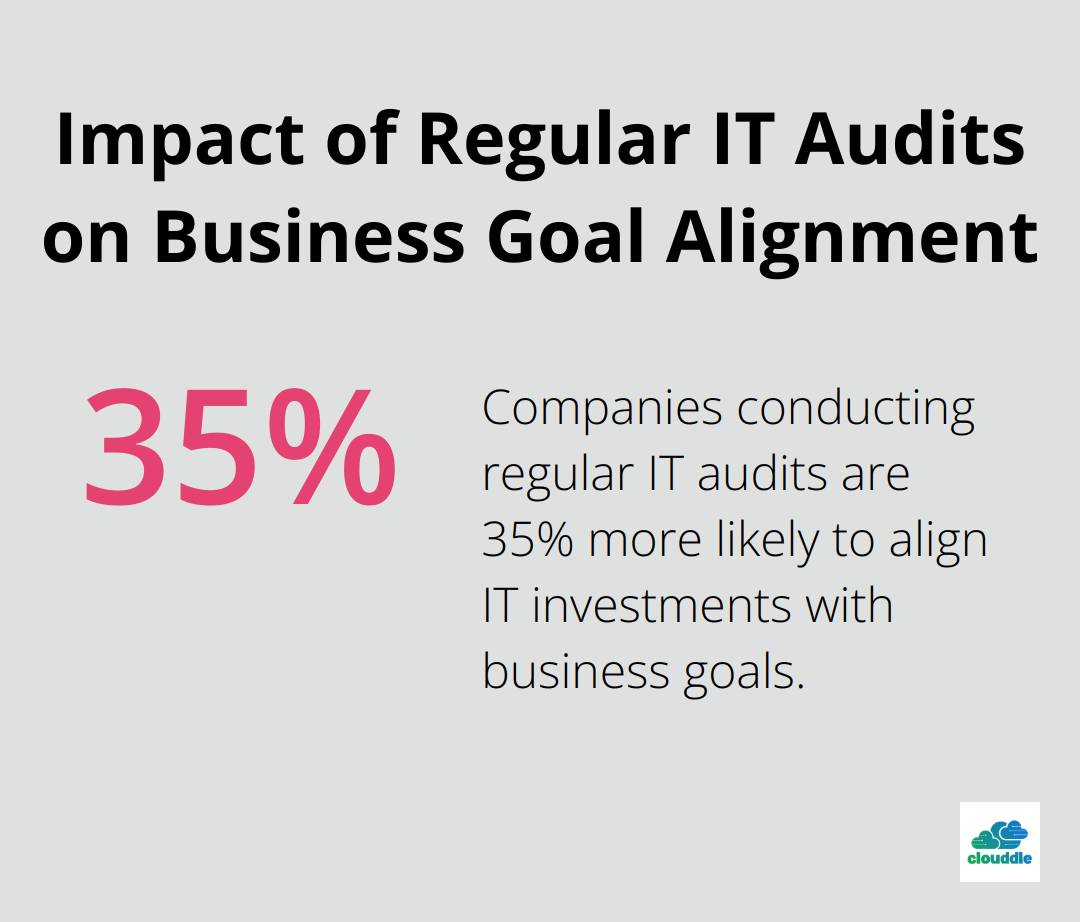Managed Services IT pricing can be complex and confusing for businesses. At Clouddle, we often see companies struggling to understand the various pricing models available in the market.
This blog post will break down the most common pricing structures, explore factors that influence costs, and provide guidance on selecting the right model for your organization.
How Do Managed IT Services Pricing Models Work?
Per-User Pricing: Simplicity Meets Scalability
Per-user pricing offers a straightforward approach: you pay a fixed amount for each user in your organization. This model typically costs between $100 to $250 per user per month (depending on the services included). It benefits companies with a stable workforce, as it allows for easy budgeting and scaling. However, costs can quickly accumulate in larger organizations.

Per-Device Pricing: Tailored to Your Hardware
Per-device pricing charges you based on the number and types of devices managed. Prices vary widely, from $5-$100 per device per month. This model suits businesses with diverse equipment but can become complex and potentially more expensive as your IT infrastructure expands.
Tiered Pricing: Flexibility in Service Levels
Tiered pricing provides different service packages at varying price points. For example, a basic tier might cost $500 per month for essential services, while a premium tier could cost $2,000+ for comprehensive coverage. This model allows businesses to select a service level that aligns with their needs and budget, but watch out for hidden costs or limitations in lower tiers.
All-Inclusive Pricing: Predictability at a Premium
All-inclusive or flat-fee pricing offers a comprehensive set of services for a fixed monthly rate. This approach provides predictable costs, making budgeting easier. It often includes essential services like network monitoring, help desk support, and more. While potentially more expensive upfront, it can prove cost-effective for businesses with complex IT needs or those who prioritize peace of mind.
A La Carte Pricing: Customization Comes at a Cost
A la carte pricing lets you pick and choose specific services. While it offers the most flexibility, it can quickly become expensive and complex to manage. Individual service costs can range from $50 to $500+ per month, depending on the specific offering. This model best suits businesses with very specific, limited IT needs.
When you select a pricing model, consider your company’s growth trajectory, IT complexity, and budget constraints. The cheapest option doesn’t always prove the most cost-effective in the long run. Many businesses benefit from a hybrid approach, combining elements of different models to create a tailored solution that optimizes both cost and service quality.
Now that we’ve explored the various pricing models, let’s examine the factors that influence managed IT services pricing. These factors play a significant role in determining the final cost and value of your IT support.
What Drives Managed IT Services Pricing?
Managed IT services pricing isn’t a one-size-fits-all affair. Various factors can significantly impact the final cost of IT support. Understanding these elements is crucial for businesses looking to make informed decisions about their IT investments.
The Scope of Services: Breadth and Depth Matter
The range of IT services you require plays a pivotal role in determining costs. Managed IT service packages typically run from $99 to $250 per user per month. Advanced cybersecurity measures, cloud services management, or specialized software support can push costs higher. A recent survey found that 46% of businesses increased their IT budgets specifically to expand their service scope.
Service Level Agreements: Quality Comes at a Price
SLAs define the quality and timeliness of service you can expect. Faster response times and higher uptime guarantees increase costs. For instance, 24/7 support with a 15-minute response time can increase your base cost by 20-30%. However, for businesses where every minute of downtime is costly, this investment can pay off. Recent statistics show that downtime costs for organizations can be significant, with some estimates reaching up to $300,000 per hour.

Company Size and Complexity: Scale Influences Pricing
Larger organizations with complex IT infrastructures naturally require more resources to manage. However, there’s often an economy of scale at play. While a small business might pay 0-0 per user, enterprise-level support can sometimes drop to -0 per user when dealing with thousands of endpoints. The key is to find a provider who can efficiently handle your scale without compromising service quality.
Industry-Specific Requirements: Compliance Adds Costs
Certain industries face stringent regulatory requirements that impact IT management. Healthcare organizations adhering to HIPAA, for example, often see a 15-25% increase in their IT costs due to necessary compliance measures. Financial services firms dealing with SOX compliance might experience similar price hikes. These additional costs, while significant, are non-negotiable for maintaining legal and operational integrity.
Geographic Location: Local Markets Affect Pricing
Your location can influence pricing due to variations in labor costs and market competition. Major tech hubs like San Francisco or New York typically see higher rates (sometimes 20-30% above the national average). However, with the rise of remote management capabilities, some businesses find cost-effective solutions by partnering with providers in lower-cost regions without sacrificing quality.
These pricing factors empower you to make strategic decisions about your IT support. It’s not just about finding the lowest price, but about identifying the solution that offers the best value for your specific needs. As we move forward, let’s explore how to choose the right pricing model for your business, considering these influential factors.
How to Select the Best Pricing Model
Perform a Comprehensive IT Audit
Start with a thorough assessment of your current IT infrastructure and needs. This audit should cover everything from the number of devices and users to the specific applications and services your business relies on. Companies that conduct regular IT audits are 35% more likely to align their IT investments with business goals (according to a Deloitte study).

Focus on your current needs and consider your growth projections for the next 3-5 years. If you plan to expand rapidly, a scalable model like per-user pricing might suit you better. For relatively stable IT needs, an all-inclusive model could provide better value.
Evaluate Your Budget and Cash Flow
Your financial situation plays a key role in selecting the right pricing model. If you have a stable, predictable cash flow, an all-inclusive or tiered pricing model might be ideal. These models offer more comprehensive coverage and can lead to long-term cost savings.
For businesses with seasonal fluctuations or uncertain cash flow due to growth, a more flexible model like per-device or a la carte pricing could benefit you. These models allow you to adjust your IT spend more easily as your needs change.
Focus on Scalability and Flexibility
The ability to scale your IT resources quickly is invaluable in today’s fast-paced business environment. A recent report exploring the thinking of 753 IT professionals highlights the importance of scalability in cloud computing.
Look for providers that offer easy scalability within their pricing models. Some providers allow you to adjust your service level or user count monthly, which can be particularly useful for businesses with fluctuating needs.
Consider the Total Cost of Ownership
When you evaluate pricing models, look beyond the monthly fee. Consider the total cost of ownership (TCO) over a 3-5 year period. This should include potential costs for upgrades, additional services, and any hardware or software investments you might need to make.
Businesses often underestimate their IT costs by 20-30% when they don’t consider TCO (according to a Gartner study). Take the time to create detailed cost projections for each pricing model you’re considering.
Seek Insights from Similar Businesses
Ask potential providers for case studies or references from businesses similar to yours. Their experiences can provide valuable insights into how different pricing models work in practice.
The best pricing model for your business will depend on your specific needs, growth plans, and financial situation. Try to find a model that provides the right balance of services, support, and cost-effectiveness for your unique business needs. Pricing models for managed IT services can vary widely, so it’s important to carefully consider your options. Remember, the cheapest option isn’t always the best value.
Final Thoughts
Managed services IT pricing models offer diverse options for businesses. Per-user, per-device, tiered, all-inclusive, and a la carte pricing each cater to different organizational needs and growth plans. Your choice should align with your business objectives, operational requirements, and long-term value considerations.
The most cost-effective solution isn’t always the cheapest upfront. A well-chosen managed IT services model can enhance operational efficiency, security, and technological capabilities. It represents an investment in your business’s future, not just an expense.
Clouddle specializes in providing tailored solutions for industries like hospitality, multi-family dwelling, and senior living. We offer managed IT, networking, Wi-Fi, and security services designed to meet specific needs and budgets. If you’re ready to explore how managed IT services can transform your operations, contact Clouddle to find a solution that aligns with your business goals.


